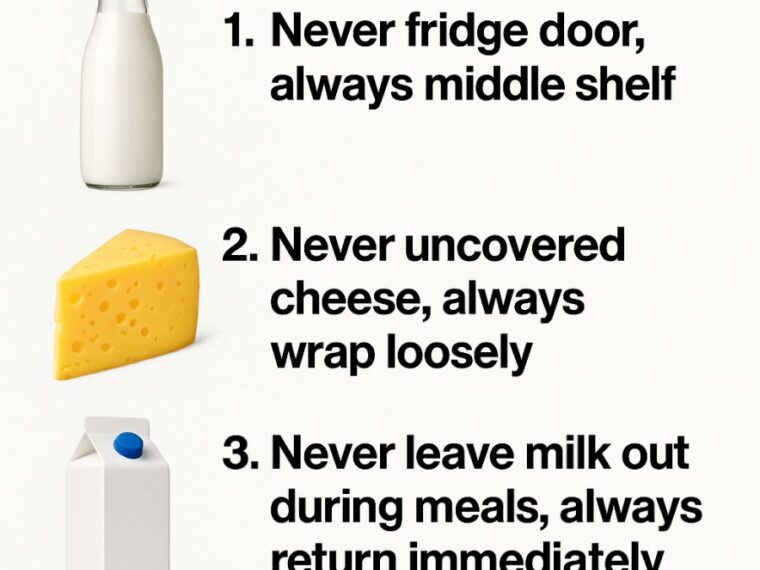When it comes to storing milk and dairy, many of us might think we’re doing it right by simply placing these items in the fridge. However, improper storage can lead to faster spoilage and food waste. Understanding the optimal conditions for storing dairy products ensures they stay fresh and safe to consume for as long as possible.
In this guide, we’ll explore the common mistakes people make when storing milk and dairy, followed by the best practices to maximize freshness and taste. By implementing these strategies, you can prevent unnecessary waste and enjoy your dairy products at their best.
1. Store Milk on the Middle Shelf, Not the Fridge Door
While the fridge door may seem like a convenient place to store milk, it’s actually the worst spot for it. The temperature of the door fluctuates more than the interior shelves due to frequent opening and closing. This can cause milk to spoil faster. Instead, place your milk on a middle shelf where the temperature is more stable, ideally between 1°C and 4°C (34°F and 39°F). This ensures that your milk stays fresh for a longer period.
2. Wrap Cheese Loosely to Allow It to Breathe
Cheese is a living food that needs to breathe to maintain its flavor and texture. Wrapping cheese tightly in plastic wrap can suffocate it and promote the growth of unwanted mold. Instead, wrap cheese loosely in parchment or wax paper, and then place it in a partially open plastic bag or container. This method allows the cheese to breathe while still retaining necessary moisture.
3. Return Milk to the Fridge Immediately After Use
Milk should not be left out at room temperature for extended periods. Each time milk is left out, it warms up slightly, which increases the growth rate of bacteria. After pouring your desired amount, promptly return the milk to the fridge. Keeping milk out of the fridge for more than two hours can significantly reduce its shelf life.
4. Finish One Carton of Milk Before Opening Another
Opening multiple cartons of milk at once leads to quicker spoilage as each carton is exposed to air and potential contaminants. To prevent this, ensure you finish one carton completely before opening another. This practice minimizes waste and ensures each carton of milk is consumed while still fresh.
5. Keep Butter in a Sealed Container to Preserve Freshness
Butter can absorb odors and flavors from other foods in the fridge. To prevent this, store butter in a sealed container. This not only helps maintain its flavor but also prevents it from becoming rancid. A butter dish with a lid or a resealable plastic container works well for this purpose.
6. Use Airtight Containers for Leftover Dairy Products
Leftover dairy products such as sour cream, yogurt, or cottage cheese should be stored in airtight containers to prevent exposure to air, which can lead to spoilage. Airtight containers also prevent the absorption of other flavors from the fridge, ensuring your dairy products maintain their intended taste.
7. Maintain a Consistent Fridge Temperature for Optimal Storage
Keeping your fridge at a consistent temperature is crucial for proper dairy storage. The optimum temperature range is between 1°C and 4°C (34°F and 39°F). Regularly check your fridge’s thermostat and adjust as needed to maintain this range. Fluctuating temperatures can lead to faster spoilage of dairy products.
8. Avoid Storing Dairy Next to Strong Odors
Dairy products can easily absorb strong odors from nearby foods, which can alter their taste and aroma. To prevent this, store dairy products away from foods with strong smells, such as onions, garlic, or certain cheeses. Consider using separate storage containers or different shelves for these items.
9. Check Expiration Dates and Rotate Stock Regularly
To ensure you’re consuming dairy products at their freshest, regularly check expiration dates and use the ‘first in, first out’ method. Place newer items at the back and older items at the front. This practice helps you consume products before they expire, reducing waste and ensuring freshness.
10. Understand the Different Storage Needs of Various Cheeses
Not all cheeses are created equal when it comes to storage. Hard cheeses like Parmesan can be stored wrapped in parchment paper in the fridge, while soft cheeses like Brie require a bit more airflow. Blue cheeses should be wrapped separately to prevent their strong flavor from affecting other foods. Understanding these differences ensures each type of cheese is stored properly to maintain its quality.
11. Use the Right Containers for Freezing Dairy
Certain dairy products can be frozen to extend their shelf life, but it’s essential to use the right containers. Milk should be frozen in containers that allow for expansion, as it will expand when frozen. Butter can be wrapped in foil and placed in a freezer bag. Cheese can be grated and frozen in airtight bags. Proper freezing techniques prevent freezer burn and preserve the quality of dairy products.





